 Krishna playing flute with his herd of cows in Bucesvara Temple, Koravangala. 12th century. | |
| Woodwind instrument | |
|---|---|
| Classification | woodwind |
| Hornbostel–Sachs classification | 421 (421.11 End-blown flutes 421.12 Side-blown flutes) |
| Developed | Unknown where flutes developed. Flutes tens-of-thousands of years old have been discovered in Europe and Asia. Bamboo flutes spread from China and India, along silk road, and across the oceans to Southeast Asia and Africa. Native Americans also made bamboo flutes. |
The bamboo flute, especially the bone flute, is one of the oldest musical instruments known.[1] Examples of Paleolithic bone flutes have survived for more than 40,000 years, to be discovered by archaeologists.[1] While the oldest flutes currently known were found in Europe, Asia too has a long history with the instrument that has continued into the present day. In China, a playable bone flute was discovered, about 9000 years old.[2]
Historians have found the bamboo flute has a long history as well, especially China and India. Flutes made history in records and artworks starting in the Zhou dynasty. The oldest written sources reveal the Chinese were using the kuan (a reed instrument) and hsio (or xiao, an end-blown flute, often of bamboo) in the 12th-11th centuries b.c., followed by the chi (or ch'ih) in the 9th century b.c. and the yüeh in the 8th century b.c.[3] Of these, the chi is the oldest documented cross flute or transverse flute, and was made from bamboo.[3][4] The Chinese have a word, zhudi, which literally means "bamboo flute."[5]
The cross flute (Sanscrit: vāṃśī) was "the outstanding wind instrument of ancient India," according to Curt Sachs.[6] He said that religious artwork depicting "celestial music" instruments was linked to music with an "aristocratic character."[6] The Indian bamboo cross flute, Bansuri, was sacred to Krishna, and he is depicted in Hindu art with the instrument.[6] In India, the cross flute appeared in reliefs from the 1st century a.d. at Sanchi and Amaravati from the 2nd-4th centuries a.d.[6][7]
In the modern age, bamboo flutes are common in places with ready access to bamboo, including Asia, South and Southeast Asia, South America, and Africa.
See: Chinese flutes
- ^ a b "Earliest music instruments found". BBC News. 25 May 2012. Archived from the original on 11 April 2022. Retrieved 30 November 2020.
- ^ "Brookhaven Lab Expert Helps Date Flute Thought to be Oldest Playable Musical Instrument, Bone flute found in China at 9,000-year-old Neolithic site". Brookhaven National Laboratory. Archived from the original on 2002-02-25. Retrieved 2020-11-30.
- ^ a b Sachs, Kurt (1940). The History of Musical Instruments. New York: W. W. Norton & Company. pp. 178–179.
- ^ "Ancient Chinese Musical Instrument's Depicted On Some Of The Early Monuments In The Museum". University of Pennsylvania Museum of Archaeology and Anthropology. Archived from the original on 2021-08-18. Retrieved 2020-11-30.
The Erh Ya (c. 400 B.C.) says the ch'ih was made of bamboo, its length was 16 inches, one hole opened upwards, and it was blown transversely.
- ^ Chen-Gia Tsai. "Chinese flutes and their music" (PDF). The Chinese Membrane Flute (dizi): Physics and Perception of its Tones (PhD thesis). Humboldt-University Berlin. Archived from the original (PDF) on 22 February 2014. Retrieved 15 February 2014 – via Graduate Institute of Musicology at National Taiwan University.
- This text appears to be: Chen Gia Tsai (28 November 2003). The Chinese Membrane Flute (dizi): Physics and Perception of its Tones (PhD thesis). Humbolt University Berlin. Archived from the original on 30 June 2023. Retrieved 30 November 2020 – via Scribd.
- ^ a b c d Sachs, Kurt (1940). The History of Musical Instruments. New York: W. W. Norton & Company. pp. 158–159, 180.
- ^ Kadel, Ram Prasad (2007). Musical Instruments of Nepal. Katmandu, Nepal: Nepali Folk Instrument Museum. p. 45. ISBN 978-9994688302.
Banshi...\transverse flute...made from bamboo with six finger holes...known as Lord Krishna's instrument.